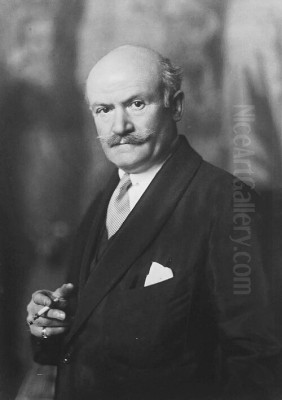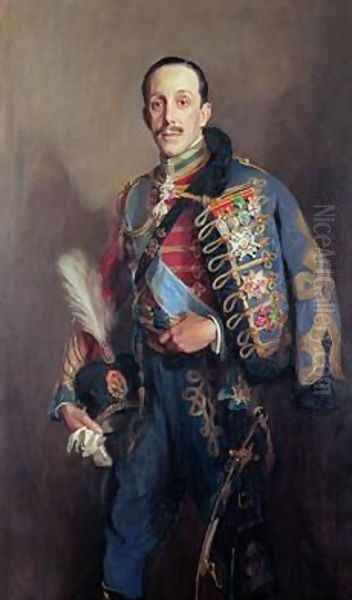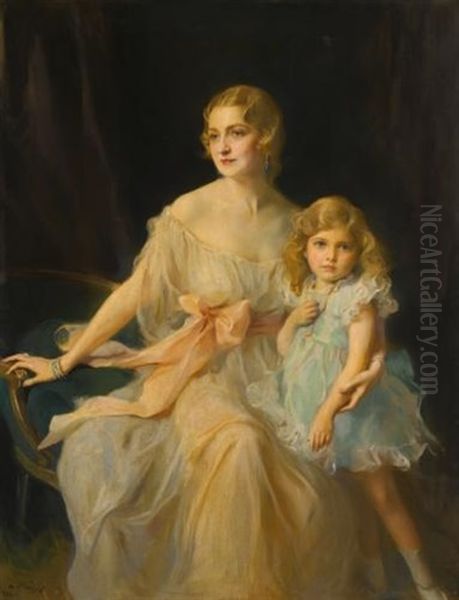
Philip Alexius de László de Lombos stands as one of the most celebrated and prolific portrait painters of the late 19th and early 20th centuries. A Hungarian-born artist who achieved immense fame primarily in Britain, his brush captured the likenesses of kings, queens, presidents, popes, aristocrats, and influential figures across Europe and America. His work provides a dazzling visual record of the elite society of his time, rendered with a distinctive blend of traditional grandeur and modern sensibility. De László's journey from humble beginnings to international renown is a testament to his exceptional talent, ambition, and adeptness at navigating the upper echelons of society.
Humble Origins and Artistic Awakening
Born Laub Fülöp Elek on April 30, 1869, in Budapest, Hungary, the artist came from modest circumstances. His father was a Jewish tailor, and the family faced financial struggles. Initially, his parents were not supportive of his artistic aspirations, perhaps envisioning a more practical trade for their son. However, the young Fülöp demonstrated an undeniable passion and talent for drawing and painting from an early age. He pursued his calling with determination, initially working in photography and porcelain painting to support himself while seeking formal art training.
His persistence paid off. He gained admission to the Hungarian National Academy of Art, where he studied under prominent Hungarian painters Bertalan Székely and Károly Lotz. These instructors grounded him in the academic traditions of drawing and composition. Seeking broader horizons, he continued his studies abroad, first at the prestigious Academy of Fine Arts in Munich, and later in Paris at the Académie Julian. In Paris, he absorbed the influences of leading French academic painters like Jules Joseph Lefebvre and Benjamin Constant, further refining his technique and understanding of portraiture.

Recognizing the potential social limitations of his birth name in the society he aimed to penetrate, Fülöp Laub officially changed his surname to the more Hungarian-sounding László in 1891. This decision marked an early step in crafting the persona that would eventually become synonymous with aristocratic portraiture. Later, particularly after receiving a title of nobility, he would adopt the style "de László," adding a touch of aristocratic flair that resonated with his clientele.
The Path to International Recognition
De László's talent quickly garnered attention. His early works showed promise, but a pivotal moment arrived in 1900. He was commissioned to paint a portrait of the aging Pope Leo XIII. This was a significant undertaking, requiring not only artistic skill but also diplomatic sensitivity. De László rose to the occasion, creating a powerful and insightful portrait that captured the pontiff's presence and authority. Submitted to the Exposition Universelle (International Exposition) in Paris that same year, the portrait was awarded a Grand Gold Medal.
This prestigious award catapulted de László onto the international stage. Suddenly, he was no longer just a promising Hungarian painter; he was an artist of global significance. The acclaim brought a flood of commissions from high society across Europe. His ability to not only capture a likeness but also to convey the sitter's status, personality, and inner life made him highly sought after. He possessed a remarkable ability to put his sitters at ease, enabling him to capture more natural and revealing expressions.
Following this success, de László began a period of extensive travel, fulfilling commissions in various European capitals. His reputation grew rapidly, solidifying his position as a leading portraitist of his generation, often mentioned in the same breath as other international stars like the American expatriate John Singer Sargent and the Spanish virtuoso Joaquín Sorolla.
Vienna and the London Zenith
In 1900, the same year as his Parisian triumph, de László married Lucy Madeleine Guinness, a member of the wealthy and influential Anglo-Irish banking and brewing family. This marriage undoubtedly facilitated his entry into the highest social circles, particularly in Britain. The couple initially settled in Vienna around 1903, where de László continued to build his practice, painting members of the Austro-Hungarian imperial family and aristocracy. Vienna, as the capital of a vast empire, provided ample opportunities for a portraitist of his calibre.

However, London beckoned as the true centre of international society and power at the turn of the century. In 1907, de László and his family relocated to England, establishing a home and studio in the fashionable South Kensington district. This move proved decisive for his career. London society embraced him, and his studio became a hub for the rich and famous. He quickly became the portraitist of choice for the British aristocracy and, crucially, the Royal Family.
He became a naturalised British subject in 1914, cementing his ties to his adopted country. His success in London was phenomenal. He was seen by many as the heir to the great British portrait tradition, following in the footsteps of masters like Sir Anthony van Dyck, Sir Joshua Reynolds, Thomas Gainsborough, and Sir Thomas Lawrence, yet with his own distinct, more modern flair. His main rival in London during this period was arguably John Singer Sargent, though their styles differed, with de László often perceived as producing more conventionally flattering, yet still psychologically astute, portraits.
Chronicler of Royalty and Power
De László's list of sitters reads like a "Who's Who" of the early 20th century. He painted numerous members of the British Royal Family, including King Edward VII, Queen Alexandra, King George V, Queen Mary, and, perhaps most famously, multiple portraits of Princess Elizabeth (the future Queen Elizabeth II) as a young girl and young woman. He also painted her parents, the Duke and Duchess of York (later King George VI and Queen Elizabeth The Queen Mother), capturing the warmth and dignity that would later endear them to the nation.
His royal commissions extended far beyond Britain. He painted Kaiser Wilhelm II of Germany, Emperor Franz Joseph of Austria-Hungary (who ennobled him in 1912, granting him the hereditary title "de Lombos," hence the full style Philip Alexius de László de Lombos), King Alfonso XIII and Queen Victoria Eugenie of Spain, Queen Marie of Romania, the King and Queen of Greece, and many other European royals. These portraits often served important diplomatic and dynastic functions, cementing relationships and projecting an image of regal stability.
Across the Atlantic, de László also found favour with American presidents and plutocrats. He painted Theodore Roosevelt, capturing his characteristic vigour. Later sitters included Presidents Warren G. Harding and Calvin Coolidge. He portrayed influential figures like Andrew W. Mellon, the financier and art collector who served as Secretary of the Treasury. His portraits of American society hostesses and their families further underscore his transatlantic appeal.
Artistic Style: Elegance and Insight
De László's style is characterized by its elegance, technical assurance, and psychological insight. While rooted in academic tradition, his work possesses a vibrancy and immediacy often associated with Impressionism, though he was not an Impressionist himself. He frequently employed bold, fluid brushwork, sometimes working alla prima (wet-on-wet) to capture fleeting expressions and the play of light. His handling of fabrics – silks, velvets, furs – and jewellery was particularly masterful, conveying texture and richness without becoming overly laboured.
He had an exceptional ability to capture not just a physical likeness but also the sitter's personality and social standing. His portraits convey an air of confidence, refinement, and often, a sense of relaxed intimacy, despite the formal context. He was adept at using composition, pose, and lighting to enhance the sitter's presence. While sometimes criticized for flattering his subjects, his best work reveals genuine character beneath the polished surface. He was often described as a "lyrical portrait painter," suggesting an ability to imbue his subjects with a certain grace and poetic quality.
Compared to contemporaries, his style was perhaps less overtly bravura than Sargent's or Sorolla's, and less starkly modern than that of emerging artists like Augustus John or Walter Sickert in Britain. He maintained a connection to the "Grand Manner" tradition, emphasizing dignity and social status, reminiscent of earlier masters like Van Dyck or Reynolds. Yet, his fluid technique and sensitivity to individual psychology place him firmly within the context of early 20th-century portraiture, alongside figures like the Italian Giovanni Boldini or the Swede Anders Zorn.
Masterpieces and Signature Works
Among de László's vast output (estimated at nearly 4,000 works), several stand out as particularly representative or historically significant.
The Portrait of Pope Leo XIII (1900) remains a landmark achievement, not only for the recognition it brought but for its powerful depiction of aged authority. It is held in high esteem and demonstrated his ability to handle subjects of immense gravitas.
His numerous portraits of the British Royal Family are central to his legacy. The charming depictions of the young Princess Elizabeth, often informal and capturing her youthful spirit, are particularly beloved. His state portraits of monarchs like George V project the required majesty, while portraits of figures like Queen Elizabeth (later the Queen Mother) convey warmth and approachability.
The Portrait of President Theodore Roosevelt (1908) successfully captures the dynamic energy and forceful personality of the American leader. It stands as a strong example of his work with prominent political figures outside the royal sphere.
Portraits like that of King Alfonso XIII of Spain or Queen Victoria Eugenie showcase his skill in depicting formal state attire and regal bearing, essential for his royal clientele. These works often reside in national collections, such as the Prado Museum in Madrid.
Works like the Portrait of Mrs. Claude Leigh and Miss Virginia Leigh demonstrate his ability to handle double portraits and capture familial relationships with sensitivity and elegance, typical of his society commissions.
He also painted intellectuals and fellow artists, though these are less numerous than his society portraits. His sitters included writers like Jerome K. Jerome and figures from the world of science and academia, although the claim he painted Edward Jenner is anachronistic, as Jenner died decades before de László's career began.
The Shadow of War: Internment and Resilience
De László's successful career faced a sudden and traumatic interruption during World War I. Despite being a naturalised British citizen since 1914 and having two sons serving in the British forces, his Hungarian birth and connections to figures in Austria-Hungary and Germany (including having painted the Kaiser) aroused suspicion in the wartime atmosphere of paranoia.
In 1917, he was accused of communicating with the enemy and arrested. He was interned for over a year, first in Brixton Prison and later in a nursing home under house arrest. The experience was deeply distressing for him and his family. He vehemently denied the charges, which appear to have stemmed from misunderstandings and perhaps anti-foreigner sentiment. Eventually, in June 1919, he was cleared of all charges and his British citizenship was restored.
Although the ordeal took a personal toll, de László showed remarkable resilience. He gradually resumed his painting career, and while the world had changed, his clientele largely remained loyal. He continued to receive prestigious commissions throughout the 1920s and 1930s, adapting his style subtly to the changing fashions of the interwar period but fundamentally remaining true to his elegant and insightful approach.
Later Years and Enduring Legacy
Philip de László continued to paint prolifically until shortly before his death. He maintained his studio in London but travelled frequently for commissions across Europe and to America. He remained a dominant figure in society portraiture, even as artistic tastes began to shift decisively towards Modernism. Artists like Pablo Picasso, Henri Matisse, and the proponents of abstraction were charting entirely new territories, making traditional portraiture seem increasingly conservative to avant-garde critics.
Despite this, de László's work never lost its appeal for his specific clientele, who valued his ability to confer dignity, elegance, and a sense of timelessness upon them. He was elected President of the Royal Society of British Artists (RBA) in 1930, a mark of respect from his peers. He received numerous honours throughout his career, including being appointed a Member of the Royal Victorian Order (MVO) by King Edward VII in 1909 for his services to the Crown.
Philip Alexius de László died of heart failure in his London home in Hampstead on November 22, 1937, at the age of 68. He left behind an enormous body of work that serves as an unparalleled visual document of the European and American elite in the decades spanning the turn of the century and the interwar years.
Interactions with the Art World
Throughout his career, de László moved within a vibrant international art scene. In Paris, he studied alongside contemporaries at the Académie Julian under figures like Lefebvre and Benjamin Constant, absorbing the academic standards of the time. His early success placed him in the company of established Salon painters. His teachers in Budapest, Székely and Lotz, connected him to the Central European artistic traditions.
In London, his primary point of comparison and sometimes rival was John Singer Sargent. Both artists catered to a similar elite clientele, though Sargent retired from portraiture relatively early, leaving de László as the preeminent society painter for many years. He would have been aware of, and his work implicitly contrasted with, other British portraitists like Sir William Orpen, known for a more vigorous and sometimes starker realism, and the bohemian Augustus John, whose style was looser and more expressive. He also worked during the time of Whistler, whose aestheticism offered a different approach to portraiture.
His international practice brought him into contact with the circles of painters like Sorolla in Spain, Zorn in Sweden, and Boldini in Paris and London – all masters of capturing the likeness and spirit of the age with dazzling technique. While de László maintained a more traditional approach than some of the emerging modernists like Walter Sickert or the Bloomsbury Group painters, his technical facility and ability to capture personality ensured his continued relevance and high regard among patrons and many fellow artists within the more established art institutions. He corresponded with figures across the art world and society, maintaining a wide network.
De László's Place in Art History
Philip Alexius de László occupies a significant, if sometimes debated, place in art history. He was undeniably one of the most successful and sought-after portrait painters of his era. His technical skill was immense, and his ability to capture both a likeness and the intangible qualities of status and personality was remarkable. He stands as the last great exponent of the Grand Manner portrait tradition, adapting it for the modern age before photography and modernist aesthetics largely displaced it.
His work provides invaluable historical documentation of the ruling classes and influential figures of a pivotal period in history – the final decades of old European monarchies and the dawn of the modern industrial and political age. His portraits are not just likenesses; they are cultural artefacts that reflect the values, aspirations, and self-image of the elite he depicted.
However, his focus on royalty and aristocracy has led some critics to view his work as primarily flattering and socially exclusive, lacking the broader social commentary or formal innovation found in more avant-garde art of the period. His style, while brilliant within its own terms, did not break new ground in the way that the Post-Impressionists or early Modernists did. Consequently, for a period after his death, particularly during the mid-20th century ascendancy of abstract art, his reputation waned.
In recent decades, however, there has been a renewed appreciation for traditional figurative painting and for artists like de László. Exhibitions and publications have brought his work back into the public eye, highlighting his technical mastery and the historical significance of his oeuvre. He is now generally recognized as a major figure in early 20th-century portraiture, a master craftsman who captured an era with unparalleled elegance and insight.
Collections and Viewing His Work
De László's prolific output means his works are distributed across numerous public institutions and private collections worldwide.
Major public collections holding significant works include:
The Royal Collection Trust, UK: Holds many portraits of the British Royal Family commissioned throughout his career.
The National Portrait Gallery, London: Features portraits of prominent British figures.
The Hungarian National Gallery, Budapest: Houses a substantial collection of his works, reflecting his Hungarian origins and early career. Major retrospectives have been held here.
The Museo Nacional del Prado, Madrid: Contains important portraits of the Spanish Royal Family, including King Alfonso XIII and Queen Victoria Eugenie.
The National Gallery of Art, Washington D.C.: Holds portraits of American figures, notably including works donated by the Mellon family.
Other institutions with de László works include university collections (portraits of academics and benefactors can be found at Oxford and Cambridge colleges, for example, the Ashmolean Museum in Oxford holds works), regional museums in the UK and Europe, and government buildings. Many portraits, particularly those of aristocratic families, remain in private hands, sometimes within the families of the original sitters. While Tate Britain has exhibited his work, its permanent collection holdings might be less extensive than the National Portrait Gallery's for this type of artist. The specific holdings mentioned for Durham University or the Hodgkin Huxley Library require careful verification, as institutional collections can change, and specific library holdings might be archival rather than displayed art.
Conclusion: A Painter of Poise and Prestige
Philip Alexius de László de Lombos was more than just a painter; he was a phenomenon in the art world of his time. Rising from humble beginnings, he used his extraordinary talent and social acumen to become the preferred portraitist of kings, queens, presidents, and the societal elite on both sides of the Atlantic. His brush captured the poise, prestige, and personality of a world that was rapidly changing, preserving the likenesses of those who shaped the early 20th century. With a style that blended traditional elegance with modern fluidity and psychological depth, de László created a legacy of portraits that continue to fascinate for their technical brilliance, historical significance, and timeless depiction of human character within the grand theatre of society. He remains a pivotal figure for understanding the art and culture of the Edwardian and interwar periods.